Internet of Things in Healthcare Industry: Literature Review and Proposed Solutions
VerifiedAdded on 2023/06/05
|13
|3074
|380
AI Summary
This paper provides a literature review on the application of Internet of Things (IoT) in the healthcare industry, highlighting the challenges and proposed solutions. It discusses the effectiveness of IoT-enabled systems in healthcare, including data security, health monitoring, and big data analysis. The paper also proposes solutions to the identified issues, such as providing training sessions to employees and measuring the effectiveness of the installed IoT system.
Contribute Materials
Your contribution can guide someone’s learning journey. Share your
documents today.
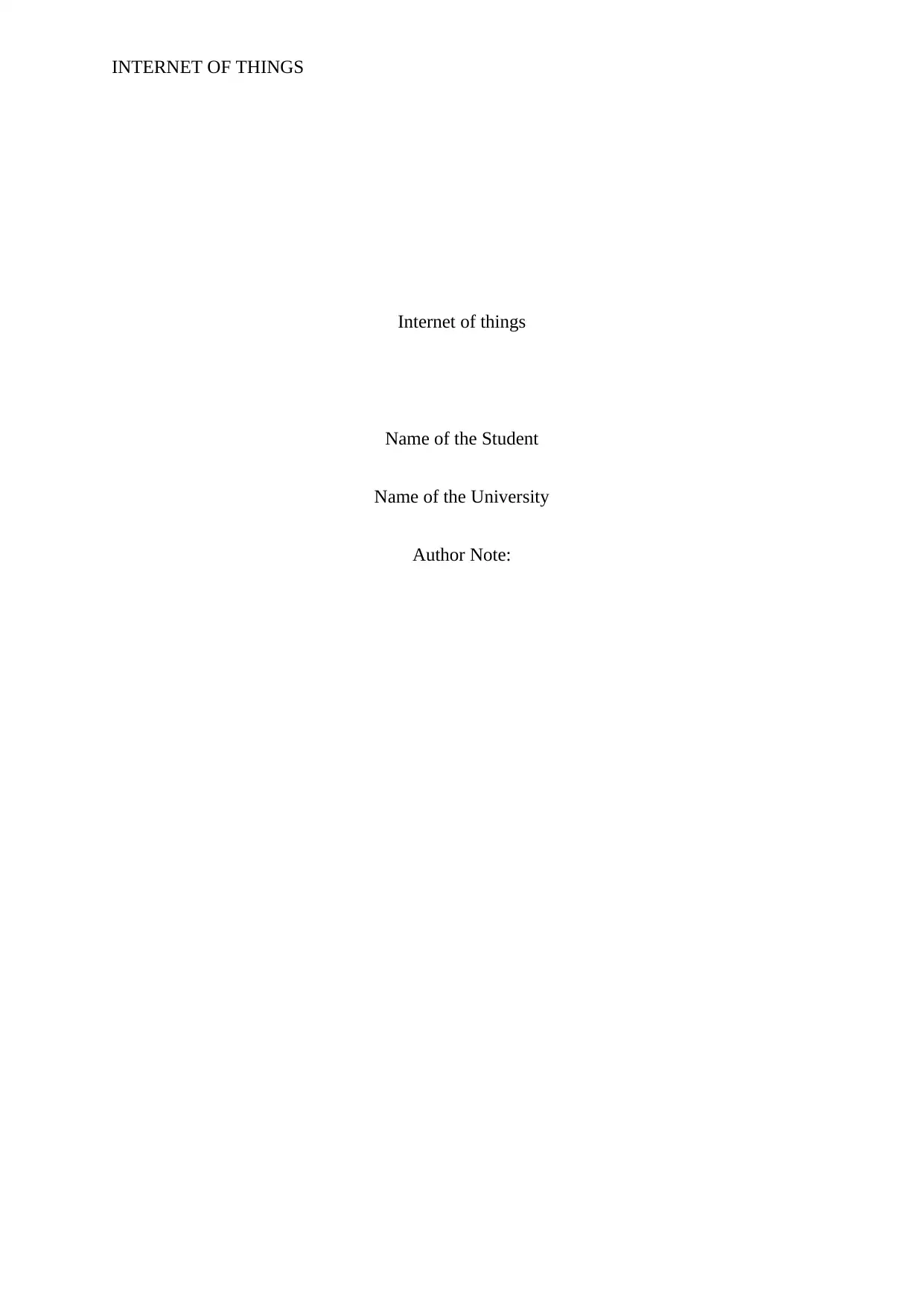
INTERNET OF THINGS
Internet of things
Name of the Student
Name of the University
Author Note:
Internet of things
Name of the Student
Name of the University
Author Note:
Secure Best Marks with AI Grader
Need help grading? Try our AI Grader for instant feedback on your assignments.
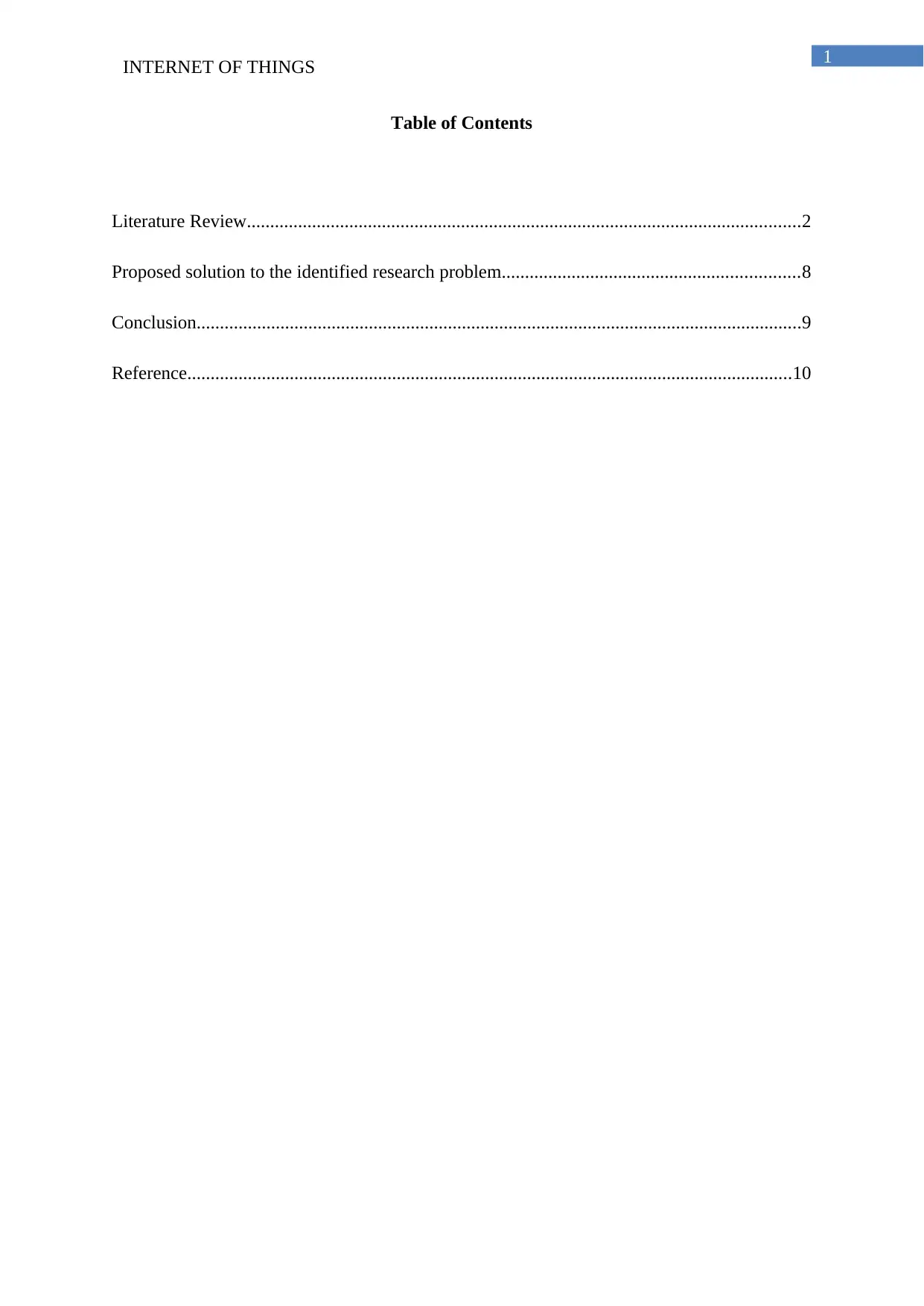
1
INTERNET OF THINGS
Table of Contents
Literature Review.......................................................................................................................2
Proposed solution to the identified research problem................................................................8
Conclusion..................................................................................................................................9
Reference..................................................................................................................................10
INTERNET OF THINGS
Table of Contents
Literature Review.......................................................................................................................2
Proposed solution to the identified research problem................................................................8
Conclusion..................................................................................................................................9
Reference..................................................................................................................................10
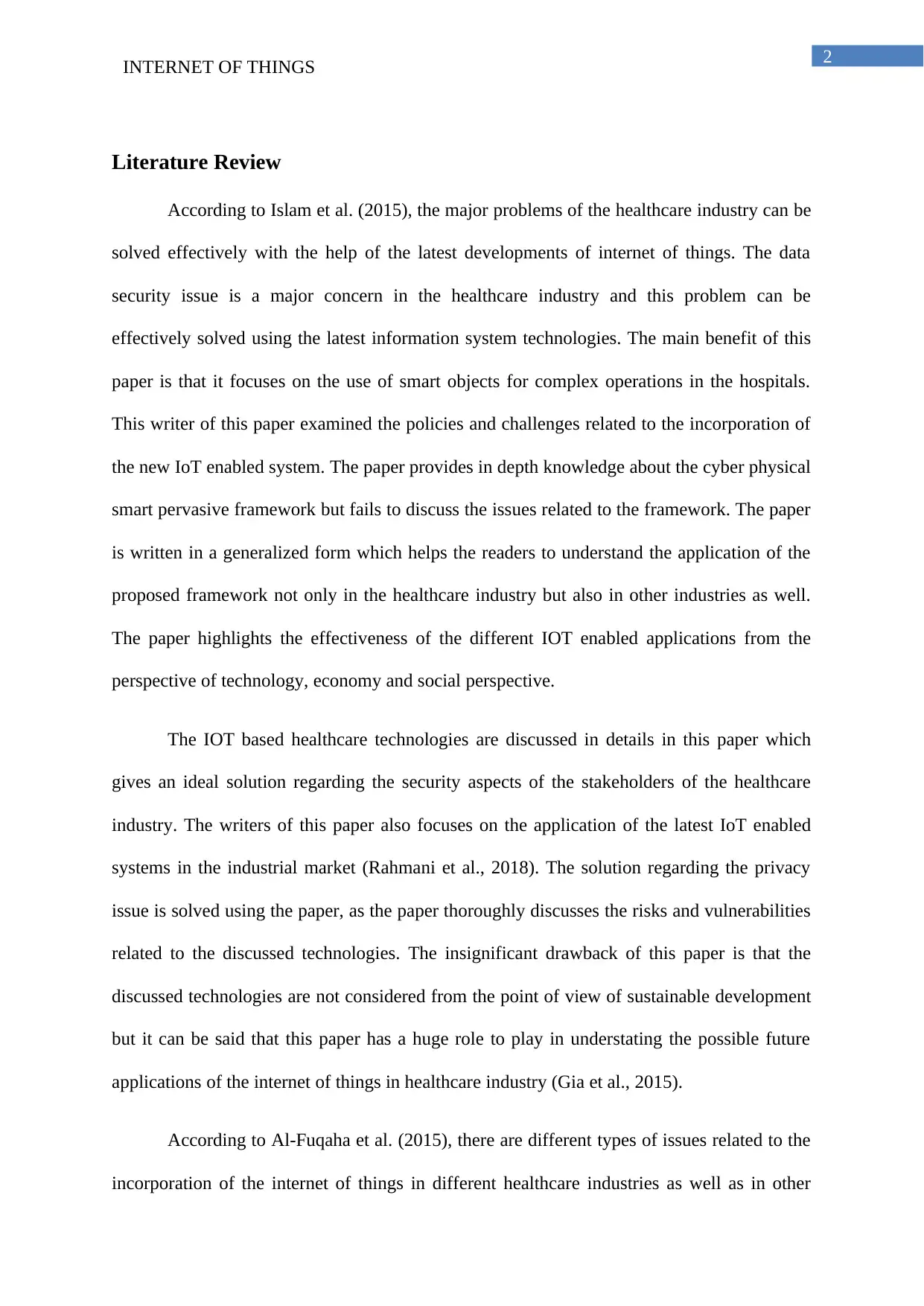
2
INTERNET OF THINGS
Literature Review
According to Islam et al. (2015), the major problems of the healthcare industry can be
solved effectively with the help of the latest developments of internet of things. The data
security issue is a major concern in the healthcare industry and this problem can be
effectively solved using the latest information system technologies. The main benefit of this
paper is that it focuses on the use of smart objects for complex operations in the hospitals.
This writer of this paper examined the policies and challenges related to the incorporation of
the new IoT enabled system. The paper provides in depth knowledge about the cyber physical
smart pervasive framework but fails to discuss the issues related to the framework. The paper
is written in a generalized form which helps the readers to understand the application of the
proposed framework not only in the healthcare industry but also in other industries as well.
The paper highlights the effectiveness of the different IOT enabled applications from the
perspective of technology, economy and social perspective.
The IOT based healthcare technologies are discussed in details in this paper which
gives an ideal solution regarding the security aspects of the stakeholders of the healthcare
industry. The writers of this paper also focuses on the application of the latest IoT enabled
systems in the industrial market (Rahmani et al., 2018). The solution regarding the privacy
issue is solved using the paper, as the paper thoroughly discusses the risks and vulnerabilities
related to the discussed technologies. The insignificant drawback of this paper is that the
discussed technologies are not considered from the point of view of sustainable development
but it can be said that this paper has a huge role to play in understating the possible future
applications of the internet of things in healthcare industry (Gia et al., 2015).
According to Al-Fuqaha et al. (2015), there are different types of issues related to the
incorporation of the internet of things in different healthcare industries as well as in other
INTERNET OF THINGS
Literature Review
According to Islam et al. (2015), the major problems of the healthcare industry can be
solved effectively with the help of the latest developments of internet of things. The data
security issue is a major concern in the healthcare industry and this problem can be
effectively solved using the latest information system technologies. The main benefit of this
paper is that it focuses on the use of smart objects for complex operations in the hospitals.
This writer of this paper examined the policies and challenges related to the incorporation of
the new IoT enabled system. The paper provides in depth knowledge about the cyber physical
smart pervasive framework but fails to discuss the issues related to the framework. The paper
is written in a generalized form which helps the readers to understand the application of the
proposed framework not only in the healthcare industry but also in other industries as well.
The paper highlights the effectiveness of the different IOT enabled applications from the
perspective of technology, economy and social perspective.
The IOT based healthcare technologies are discussed in details in this paper which
gives an ideal solution regarding the security aspects of the stakeholders of the healthcare
industry. The writers of this paper also focuses on the application of the latest IoT enabled
systems in the industrial market (Rahmani et al., 2018). The solution regarding the privacy
issue is solved using the paper, as the paper thoroughly discusses the risks and vulnerabilities
related to the discussed technologies. The insignificant drawback of this paper is that the
discussed technologies are not considered from the point of view of sustainable development
but it can be said that this paper has a huge role to play in understating the possible future
applications of the internet of things in healthcare industry (Gia et al., 2015).
According to Al-Fuqaha et al. (2015), there are different types of issues related to the
incorporation of the internet of things in different healthcare industries as well as in other
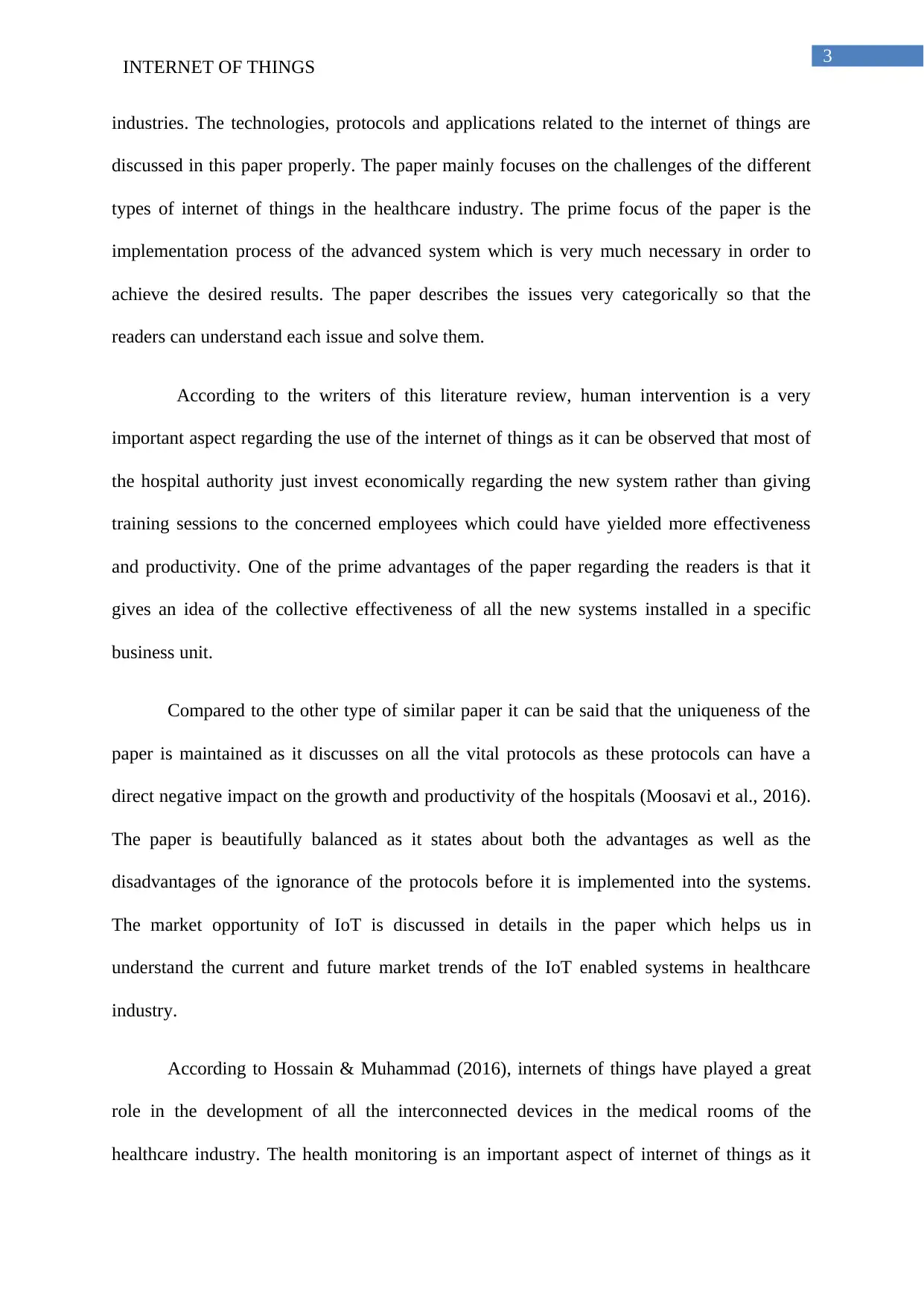
3
INTERNET OF THINGS
industries. The technologies, protocols and applications related to the internet of things are
discussed in this paper properly. The paper mainly focuses on the challenges of the different
types of internet of things in the healthcare industry. The prime focus of the paper is the
implementation process of the advanced system which is very much necessary in order to
achieve the desired results. The paper describes the issues very categorically so that the
readers can understand each issue and solve them.
According to the writers of this literature review, human intervention is a very
important aspect regarding the use of the internet of things as it can be observed that most of
the hospital authority just invest economically regarding the new system rather than giving
training sessions to the concerned employees which could have yielded more effectiveness
and productivity. One of the prime advantages of the paper regarding the readers is that it
gives an idea of the collective effectiveness of all the new systems installed in a specific
business unit.
Compared to the other type of similar paper it can be said that the uniqueness of the
paper is maintained as it discusses on all the vital protocols as these protocols can have a
direct negative impact on the growth and productivity of the hospitals (Moosavi et al., 2016).
The paper is beautifully balanced as it states about both the advantages as well as the
disadvantages of the ignorance of the protocols before it is implemented into the systems.
The market opportunity of IoT is discussed in details in the paper which helps us in
understand the current and future market trends of the IoT enabled systems in healthcare
industry.
According to Hossain & Muhammad (2016), internets of things have played a great
role in the development of all the interconnected devices in the medical rooms of the
healthcare industry. The health monitoring is an important aspect of internet of things as it
INTERNET OF THINGS
industries. The technologies, protocols and applications related to the internet of things are
discussed in this paper properly. The paper mainly focuses on the challenges of the different
types of internet of things in the healthcare industry. The prime focus of the paper is the
implementation process of the advanced system which is very much necessary in order to
achieve the desired results. The paper describes the issues very categorically so that the
readers can understand each issue and solve them.
According to the writers of this literature review, human intervention is a very
important aspect regarding the use of the internet of things as it can be observed that most of
the hospital authority just invest economically regarding the new system rather than giving
training sessions to the concerned employees which could have yielded more effectiveness
and productivity. One of the prime advantages of the paper regarding the readers is that it
gives an idea of the collective effectiveness of all the new systems installed in a specific
business unit.
Compared to the other type of similar paper it can be said that the uniqueness of the
paper is maintained as it discusses on all the vital protocols as these protocols can have a
direct negative impact on the growth and productivity of the hospitals (Moosavi et al., 2016).
The paper is beautifully balanced as it states about both the advantages as well as the
disadvantages of the ignorance of the protocols before it is implemented into the systems.
The market opportunity of IoT is discussed in details in the paper which helps us in
understand the current and future market trends of the IoT enabled systems in healthcare
industry.
According to Hossain & Muhammad (2016), internets of things have played a great
role in the development of all the interconnected devices in the medical rooms of the
healthcare industry. The health monitoring is an important aspect of internet of things as it
Secure Best Marks with AI Grader
Need help grading? Try our AI Grader for instant feedback on your assignments.
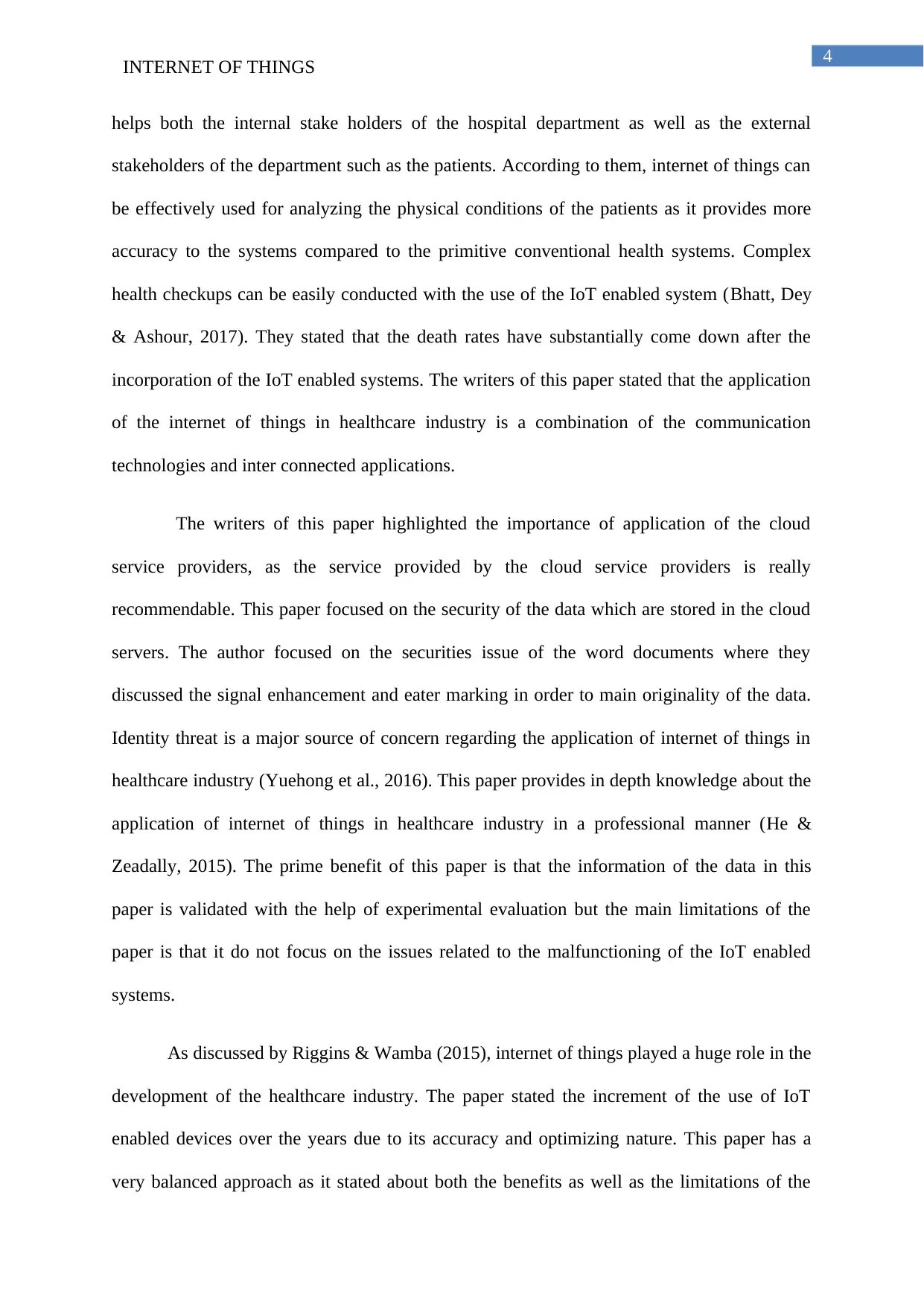
4
INTERNET OF THINGS
helps both the internal stake holders of the hospital department as well as the external
stakeholders of the department such as the patients. According to them, internet of things can
be effectively used for analyzing the physical conditions of the patients as it provides more
accuracy to the systems compared to the primitive conventional health systems. Complex
health checkups can be easily conducted with the use of the IoT enabled system (Bhatt, Dey
& Ashour, 2017). They stated that the death rates have substantially come down after the
incorporation of the IoT enabled systems. The writers of this paper stated that the application
of the internet of things in healthcare industry is a combination of the communication
technologies and inter connected applications.
The writers of this paper highlighted the importance of application of the cloud
service providers, as the service provided by the cloud service providers is really
recommendable. This paper focused on the security of the data which are stored in the cloud
servers. The author focused on the securities issue of the word documents where they
discussed the signal enhancement and eater marking in order to main originality of the data.
Identity threat is a major source of concern regarding the application of internet of things in
healthcare industry (Yuehong et al., 2016). This paper provides in depth knowledge about the
application of internet of things in healthcare industry in a professional manner (He &
Zeadally, 2015). The prime benefit of this paper is that the information of the data in this
paper is validated with the help of experimental evaluation but the main limitations of the
paper is that it do not focus on the issues related to the malfunctioning of the IoT enabled
systems.
As discussed by Riggins & Wamba (2015), internet of things played a huge role in the
development of the healthcare industry. The paper stated the increment of the use of IoT
enabled devices over the years due to its accuracy and optimizing nature. This paper has a
very balanced approach as it stated about both the benefits as well as the limitations of the
INTERNET OF THINGS
helps both the internal stake holders of the hospital department as well as the external
stakeholders of the department such as the patients. According to them, internet of things can
be effectively used for analyzing the physical conditions of the patients as it provides more
accuracy to the systems compared to the primitive conventional health systems. Complex
health checkups can be easily conducted with the use of the IoT enabled system (Bhatt, Dey
& Ashour, 2017). They stated that the death rates have substantially come down after the
incorporation of the IoT enabled systems. The writers of this paper stated that the application
of the internet of things in healthcare industry is a combination of the communication
technologies and inter connected applications.
The writers of this paper highlighted the importance of application of the cloud
service providers, as the service provided by the cloud service providers is really
recommendable. This paper focused on the security of the data which are stored in the cloud
servers. The author focused on the securities issue of the word documents where they
discussed the signal enhancement and eater marking in order to main originality of the data.
Identity threat is a major source of concern regarding the application of internet of things in
healthcare industry (Yuehong et al., 2016). This paper provides in depth knowledge about the
application of internet of things in healthcare industry in a professional manner (He &
Zeadally, 2015). The prime benefit of this paper is that the information of the data in this
paper is validated with the help of experimental evaluation but the main limitations of the
paper is that it do not focus on the issues related to the malfunctioning of the IoT enabled
systems.
As discussed by Riggins & Wamba (2015), internet of things played a huge role in the
development of the healthcare industry. The paper stated the increment of the use of IoT
enabled devices over the years due to its accuracy and optimizing nature. This paper has a
very balanced approach as it stated about both the benefits as well as the limitations of the
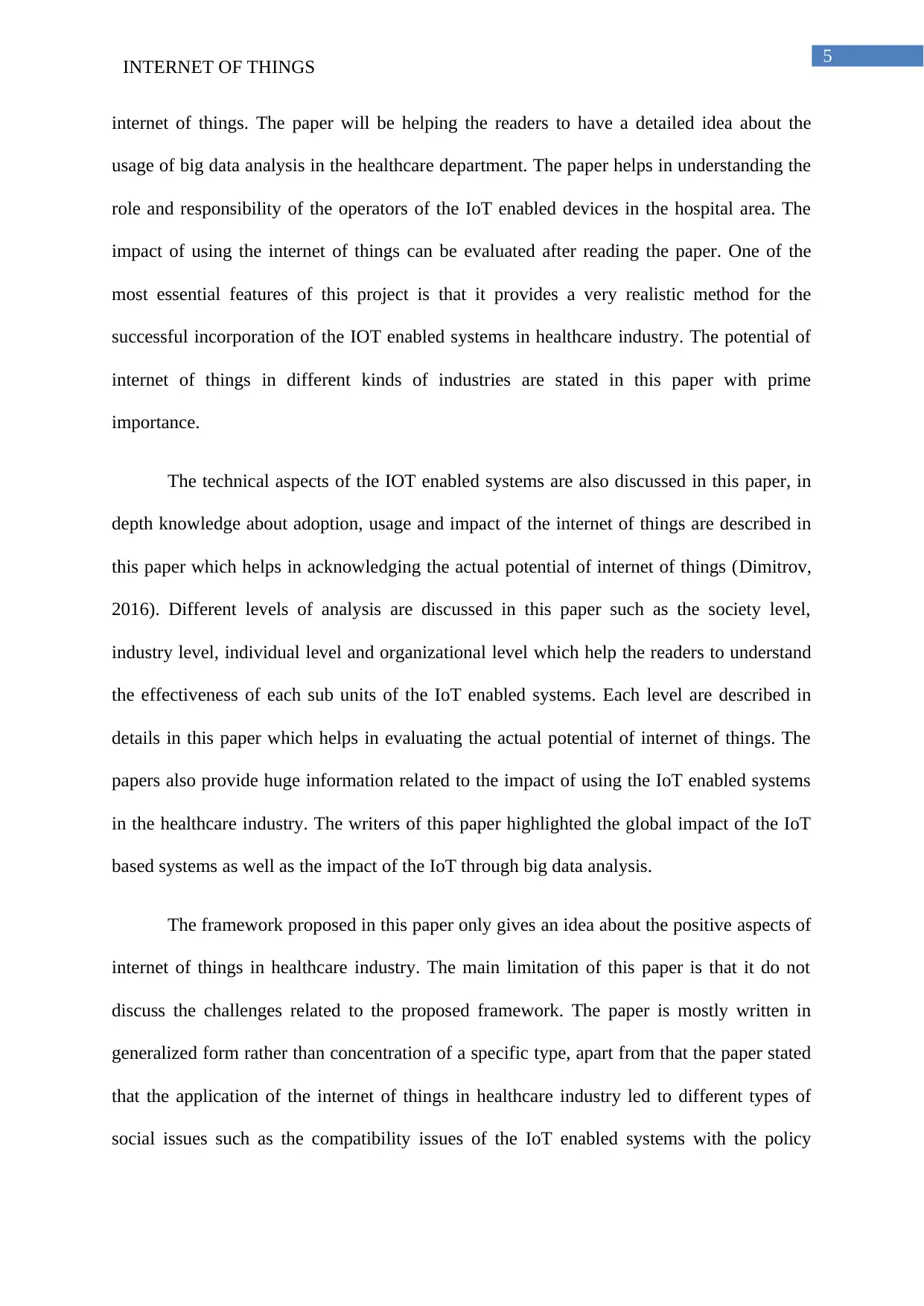
5
INTERNET OF THINGS
internet of things. The paper will be helping the readers to have a detailed idea about the
usage of big data analysis in the healthcare department. The paper helps in understanding the
role and responsibility of the operators of the IoT enabled devices in the hospital area. The
impact of using the internet of things can be evaluated after reading the paper. One of the
most essential features of this project is that it provides a very realistic method for the
successful incorporation of the IOT enabled systems in healthcare industry. The potential of
internet of things in different kinds of industries are stated in this paper with prime
importance.
The technical aspects of the IOT enabled systems are also discussed in this paper, in
depth knowledge about adoption, usage and impact of the internet of things are described in
this paper which helps in acknowledging the actual potential of internet of things (Dimitrov,
2016). Different levels of analysis are discussed in this paper such as the society level,
industry level, individual level and organizational level which help the readers to understand
the effectiveness of each sub units of the IoT enabled systems. Each level are described in
details in this paper which helps in evaluating the actual potential of internet of things. The
papers also provide huge information related to the impact of using the IoT enabled systems
in the healthcare industry. The writers of this paper highlighted the global impact of the IoT
based systems as well as the impact of the IoT through big data analysis.
The framework proposed in this paper only gives an idea about the positive aspects of
internet of things in healthcare industry. The main limitation of this paper is that it do not
discuss the challenges related to the proposed framework. The paper is mostly written in
generalized form rather than concentration of a specific type, apart from that the paper stated
that the application of the internet of things in healthcare industry led to different types of
social issues such as the compatibility issues of the IoT enabled systems with the policy
INTERNET OF THINGS
internet of things. The paper will be helping the readers to have a detailed idea about the
usage of big data analysis in the healthcare department. The paper helps in understanding the
role and responsibility of the operators of the IoT enabled devices in the hospital area. The
impact of using the internet of things can be evaluated after reading the paper. One of the
most essential features of this project is that it provides a very realistic method for the
successful incorporation of the IOT enabled systems in healthcare industry. The potential of
internet of things in different kinds of industries are stated in this paper with prime
importance.
The technical aspects of the IOT enabled systems are also discussed in this paper, in
depth knowledge about adoption, usage and impact of the internet of things are described in
this paper which helps in acknowledging the actual potential of internet of things (Dimitrov,
2016). Different levels of analysis are discussed in this paper such as the society level,
industry level, individual level and organizational level which help the readers to understand
the effectiveness of each sub units of the IoT enabled systems. Each level are described in
details in this paper which helps in evaluating the actual potential of internet of things. The
papers also provide huge information related to the impact of using the IoT enabled systems
in the healthcare industry. The writers of this paper highlighted the global impact of the IoT
based systems as well as the impact of the IoT through big data analysis.
The framework proposed in this paper only gives an idea about the positive aspects of
internet of things in healthcare industry. The main limitation of this paper is that it do not
discuss the challenges related to the proposed framework. The paper is mostly written in
generalized form rather than concentration of a specific type, apart from that the paper stated
that the application of the internet of things in healthcare industry led to different types of
social issues such as the compatibility issues of the IoT enabled systems with the policy
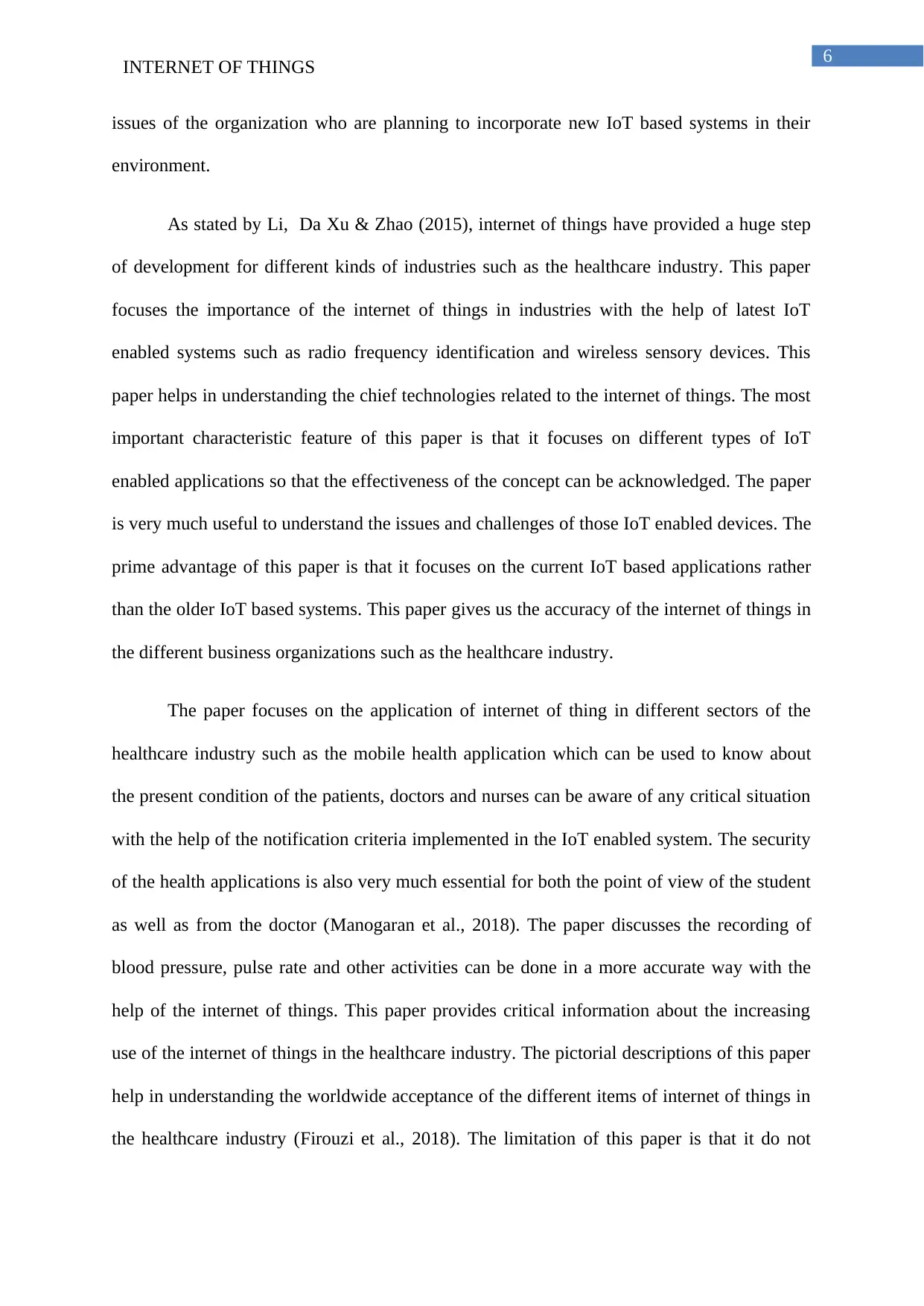
6
INTERNET OF THINGS
issues of the organization who are planning to incorporate new IoT based systems in their
environment.
As stated by Li, Da Xu & Zhao (2015), internet of things have provided a huge step
of development for different kinds of industries such as the healthcare industry. This paper
focuses the importance of the internet of things in industries with the help of latest IoT
enabled systems such as radio frequency identification and wireless sensory devices. This
paper helps in understanding the chief technologies related to the internet of things. The most
important characteristic feature of this paper is that it focuses on different types of IoT
enabled applications so that the effectiveness of the concept can be acknowledged. The paper
is very much useful to understand the issues and challenges of those IoT enabled devices. The
prime advantage of this paper is that it focuses on the current IoT based applications rather
than the older IoT based systems. This paper gives us the accuracy of the internet of things in
the different business organizations such as the healthcare industry.
The paper focuses on the application of internet of thing in different sectors of the
healthcare industry such as the mobile health application which can be used to know about
the present condition of the patients, doctors and nurses can be aware of any critical situation
with the help of the notification criteria implemented in the IoT enabled system. The security
of the health applications is also very much essential for both the point of view of the student
as well as from the doctor (Manogaran et al., 2018). The paper discusses the recording of
blood pressure, pulse rate and other activities can be done in a more accurate way with the
help of the internet of things. This paper provides critical information about the increasing
use of the internet of things in the healthcare industry. The pictorial descriptions of this paper
help in understanding the worldwide acceptance of the different items of internet of things in
the healthcare industry (Firouzi et al., 2018). The limitation of this paper is that it do not
INTERNET OF THINGS
issues of the organization who are planning to incorporate new IoT based systems in their
environment.
As stated by Li, Da Xu & Zhao (2015), internet of things have provided a huge step
of development for different kinds of industries such as the healthcare industry. This paper
focuses the importance of the internet of things in industries with the help of latest IoT
enabled systems such as radio frequency identification and wireless sensory devices. This
paper helps in understanding the chief technologies related to the internet of things. The most
important characteristic feature of this paper is that it focuses on different types of IoT
enabled applications so that the effectiveness of the concept can be acknowledged. The paper
is very much useful to understand the issues and challenges of those IoT enabled devices. The
prime advantage of this paper is that it focuses on the current IoT based applications rather
than the older IoT based systems. This paper gives us the accuracy of the internet of things in
the different business organizations such as the healthcare industry.
The paper focuses on the application of internet of thing in different sectors of the
healthcare industry such as the mobile health application which can be used to know about
the present condition of the patients, doctors and nurses can be aware of any critical situation
with the help of the notification criteria implemented in the IoT enabled system. The security
of the health applications is also very much essential for both the point of view of the student
as well as from the doctor (Manogaran et al., 2018). The paper discusses the recording of
blood pressure, pulse rate and other activities can be done in a more accurate way with the
help of the internet of things. This paper provides critical information about the increasing
use of the internet of things in the healthcare industry. The pictorial descriptions of this paper
help in understanding the worldwide acceptance of the different items of internet of things in
the healthcare industry (Firouzi et al., 2018). The limitation of this paper is that it do not
Paraphrase This Document
Need a fresh take? Get an instant paraphrase of this document with our AI Paraphraser
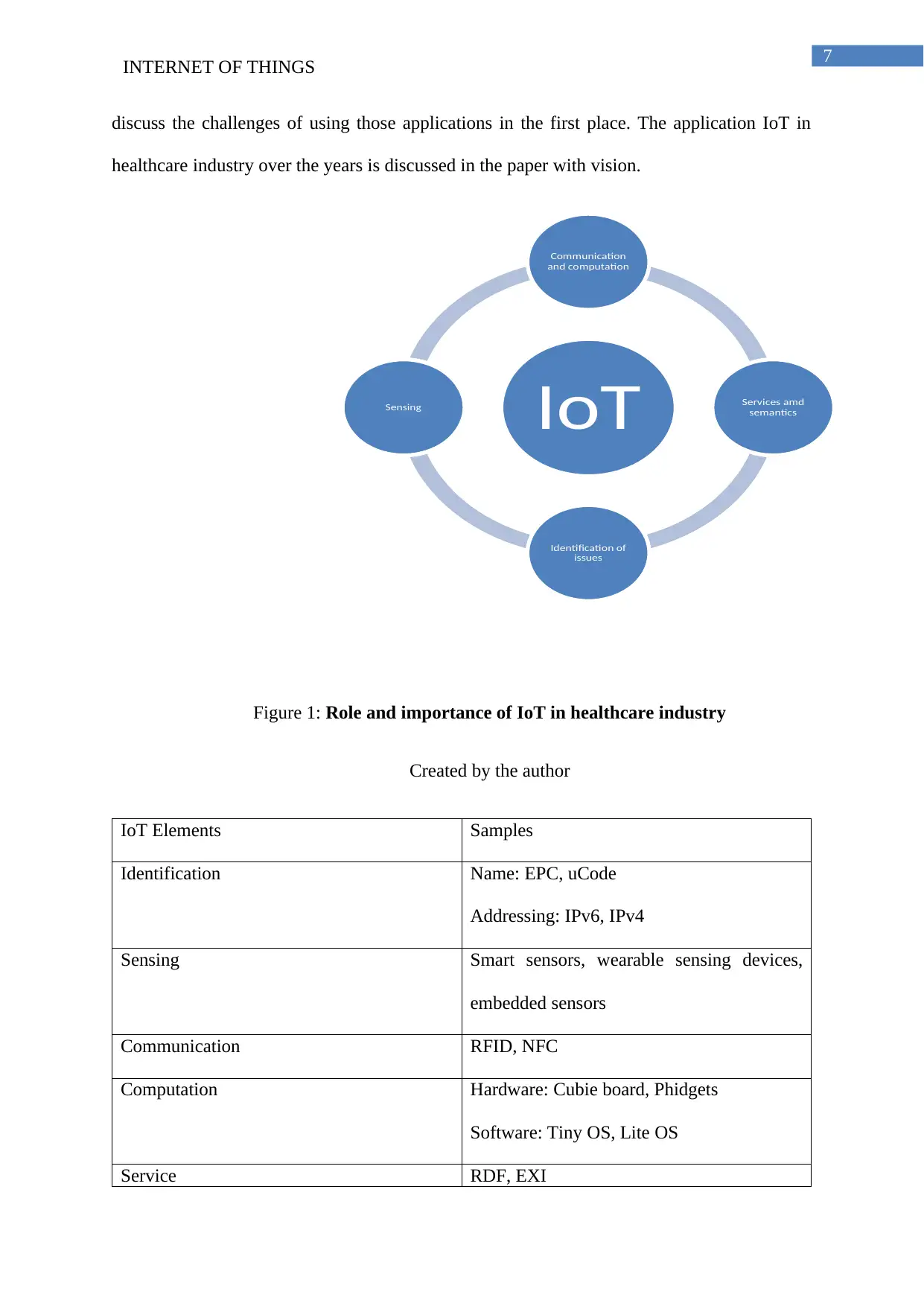
7
INTERNET OF THINGS
discuss the challenges of using those applications in the first place. The application IoT in
healthcare industry over the years is discussed in the paper with vision.
Figure 1: Role and importance of IoT in healthcare industry
Created by the author
IoT Elements Samples
Identification Name: EPC, uCode
Addressing: IPv6, IPv4
Sensing Smart sensors, wearable sensing devices,
embedded sensors
Communication RFID, NFC
Computation Hardware: Cubie board, Phidgets
Software: Tiny OS, Lite OS
Service RDF, EXI
IoT
Communication
and computation
Services amd
semantics
Identification of
issues
Sensing
INTERNET OF THINGS
discuss the challenges of using those applications in the first place. The application IoT in
healthcare industry over the years is discussed in the paper with vision.
Figure 1: Role and importance of IoT in healthcare industry
Created by the author
IoT Elements Samples
Identification Name: EPC, uCode
Addressing: IPv6, IPv4
Sensing Smart sensors, wearable sensing devices,
embedded sensors
Communication RFID, NFC
Computation Hardware: Cubie board, Phidgets
Software: Tiny OS, Lite OS
Service RDF, EXI
IoT
Communication
and computation
Services amd
semantics
Identification of
issues
Sensing
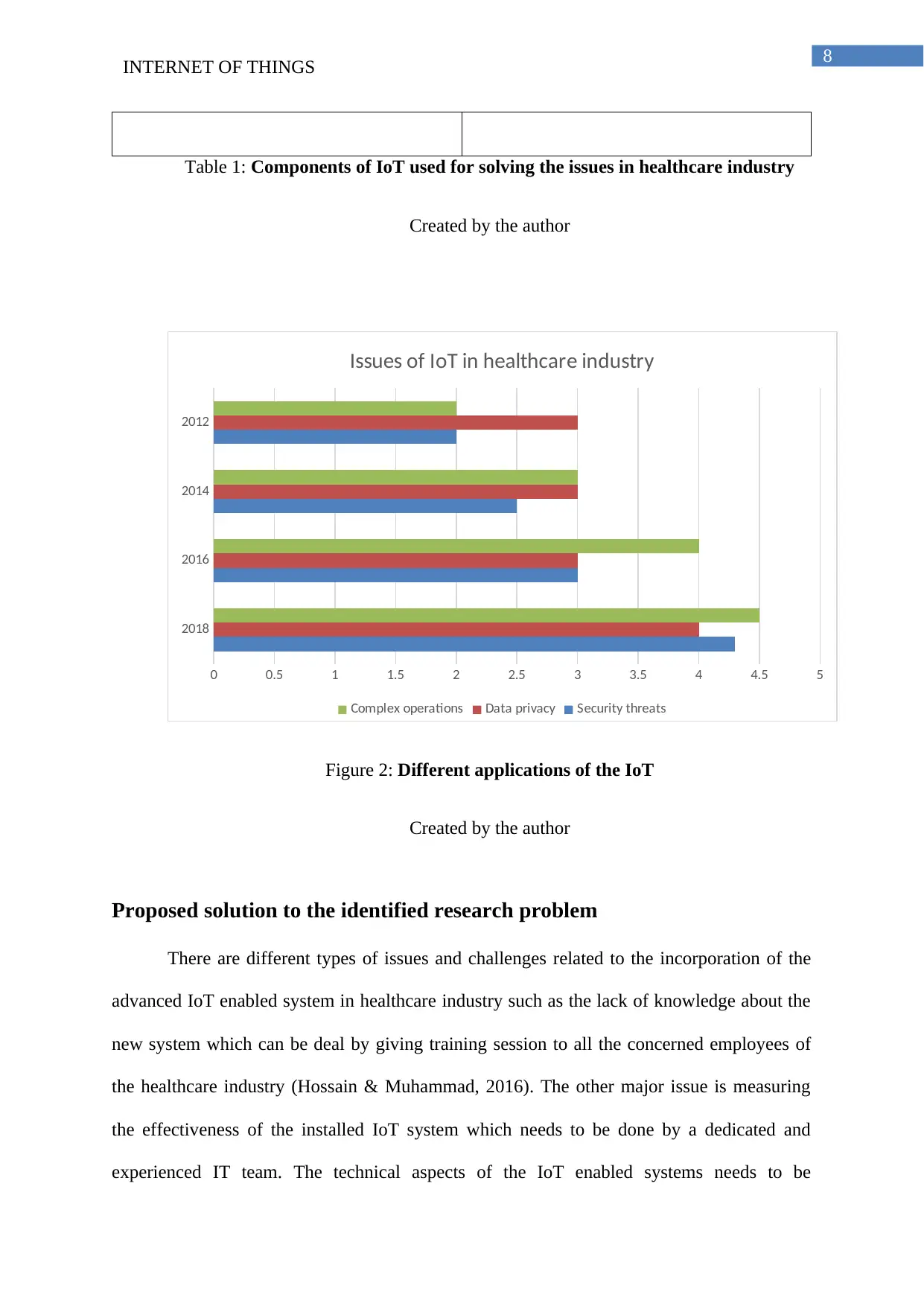
8
INTERNET OF THINGS
Table 1: Components of IoT used for solving the issues in healthcare industry
Created by the author
2018
2016
2014
2012
0 0.5 1 1.5 2 2.5 3 3.5 4 4.5 5
Issues of IoT in healthcare industry
Complex operations Data privacy Security threats
Figure 2: Different applications of the IoT
Created by the author
Proposed solution to the identified research problem
There are different types of issues and challenges related to the incorporation of the
advanced IoT enabled system in healthcare industry such as the lack of knowledge about the
new system which can be deal by giving training session to all the concerned employees of
the healthcare industry (Hossain & Muhammad, 2016). The other major issue is measuring
the effectiveness of the installed IoT system which needs to be done by a dedicated and
experienced IT team. The technical aspects of the IoT enabled systems needs to be
INTERNET OF THINGS
Table 1: Components of IoT used for solving the issues in healthcare industry
Created by the author
2018
2016
2014
2012
0 0.5 1 1.5 2 2.5 3 3.5 4 4.5 5
Issues of IoT in healthcare industry
Complex operations Data privacy Security threats
Figure 2: Different applications of the IoT
Created by the author
Proposed solution to the identified research problem
There are different types of issues and challenges related to the incorporation of the
advanced IoT enabled system in healthcare industry such as the lack of knowledge about the
new system which can be deal by giving training session to all the concerned employees of
the healthcare industry (Hossain & Muhammad, 2016). The other major issue is measuring
the effectiveness of the installed IoT system which needs to be done by a dedicated and
experienced IT team. The technical aspects of the IoT enabled systems needs to be
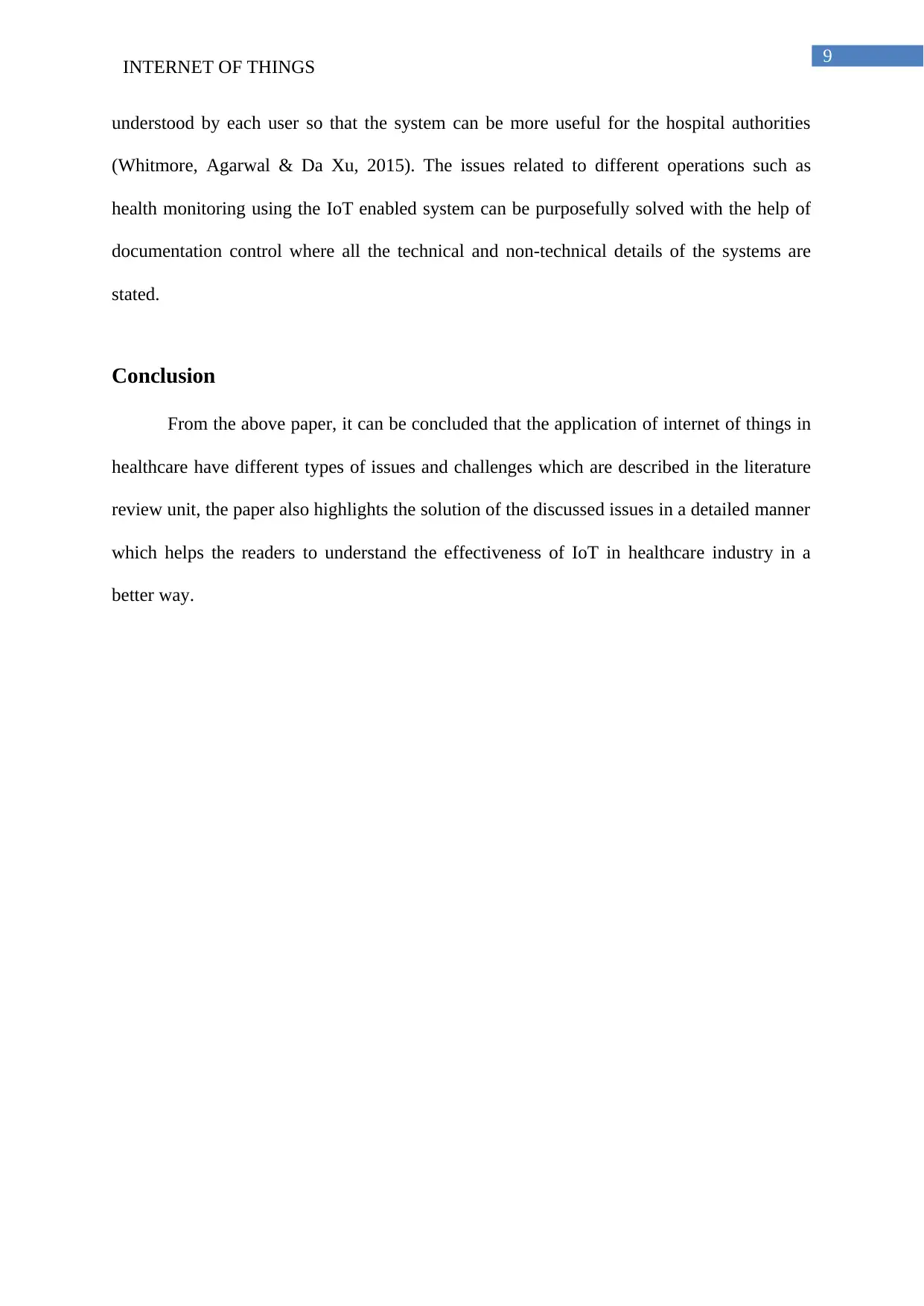
9
INTERNET OF THINGS
understood by each user so that the system can be more useful for the hospital authorities
(Whitmore, Agarwal & Da Xu, 2015). The issues related to different operations such as
health monitoring using the IoT enabled system can be purposefully solved with the help of
documentation control where all the technical and non-technical details of the systems are
stated.
Conclusion
From the above paper, it can be concluded that the application of internet of things in
healthcare have different types of issues and challenges which are described in the literature
review unit, the paper also highlights the solution of the discussed issues in a detailed manner
which helps the readers to understand the effectiveness of IoT in healthcare industry in a
better way.
INTERNET OF THINGS
understood by each user so that the system can be more useful for the hospital authorities
(Whitmore, Agarwal & Da Xu, 2015). The issues related to different operations such as
health monitoring using the IoT enabled system can be purposefully solved with the help of
documentation control where all the technical and non-technical details of the systems are
stated.
Conclusion
From the above paper, it can be concluded that the application of internet of things in
healthcare have different types of issues and challenges which are described in the literature
review unit, the paper also highlights the solution of the discussed issues in a detailed manner
which helps the readers to understand the effectiveness of IoT in healthcare industry in a
better way.
Secure Best Marks with AI Grader
Need help grading? Try our AI Grader for instant feedback on your assignments.
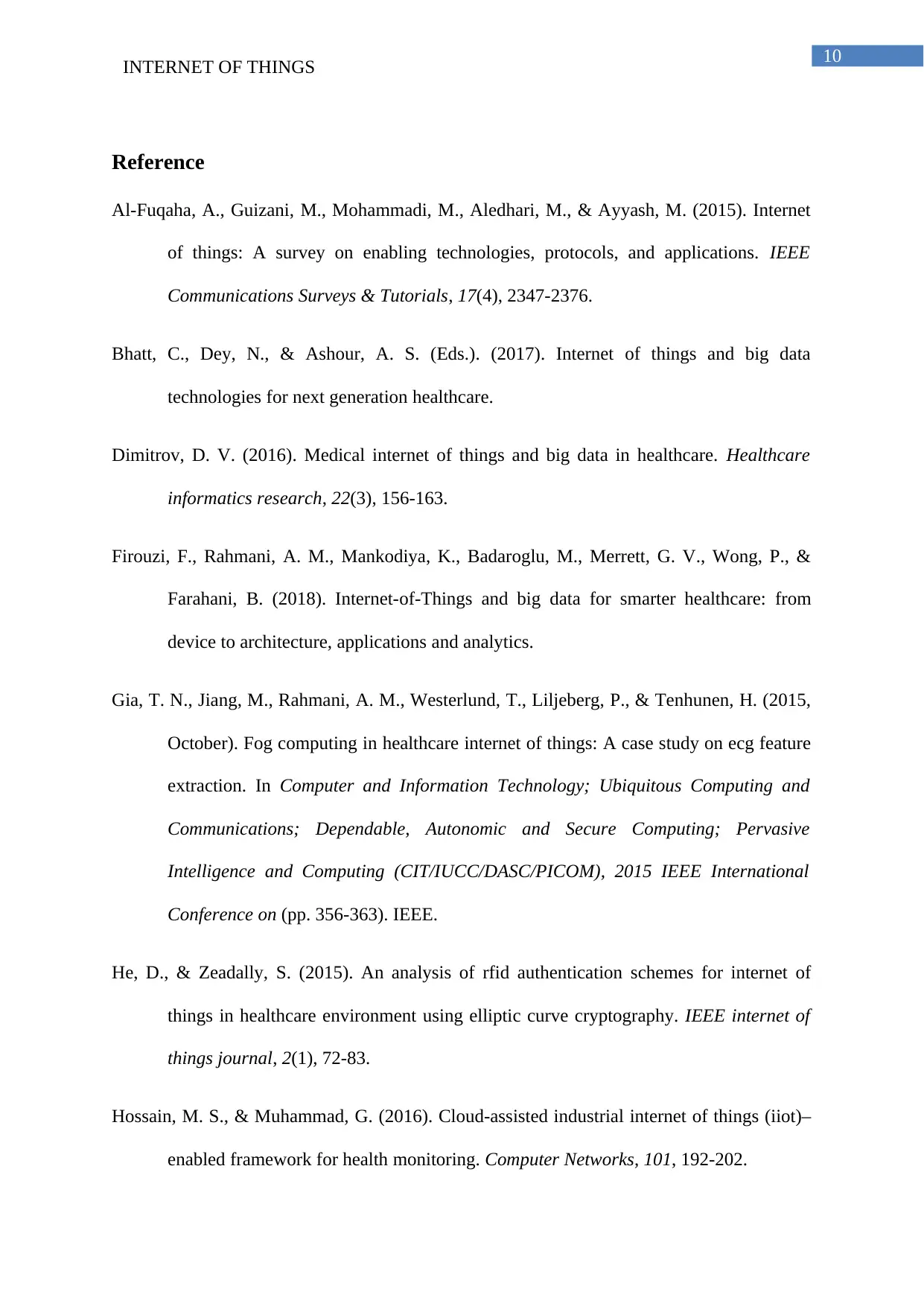
10
INTERNET OF THINGS
Reference
Al-Fuqaha, A., Guizani, M., Mohammadi, M., Aledhari, M., & Ayyash, M. (2015). Internet
of things: A survey on enabling technologies, protocols, and applications. IEEE
Communications Surveys & Tutorials, 17(4), 2347-2376.
Bhatt, C., Dey, N., & Ashour, A. S. (Eds.). (2017). Internet of things and big data
technologies for next generation healthcare.
Dimitrov, D. V. (2016). Medical internet of things and big data in healthcare. Healthcare
informatics research, 22(3), 156-163.
Firouzi, F., Rahmani, A. M., Mankodiya, K., Badaroglu, M., Merrett, G. V., Wong, P., &
Farahani, B. (2018). Internet-of-Things and big data for smarter healthcare: from
device to architecture, applications and analytics.
Gia, T. N., Jiang, M., Rahmani, A. M., Westerlund, T., Liljeberg, P., & Tenhunen, H. (2015,
October). Fog computing in healthcare internet of things: A case study on ecg feature
extraction. In Computer and Information Technology; Ubiquitous Computing and
Communications; Dependable, Autonomic and Secure Computing; Pervasive
Intelligence and Computing (CIT/IUCC/DASC/PICOM), 2015 IEEE International
Conference on (pp. 356-363). IEEE.
He, D., & Zeadally, S. (2015). An analysis of rfid authentication schemes for internet of
things in healthcare environment using elliptic curve cryptography. IEEE internet of
things journal, 2(1), 72-83.
Hossain, M. S., & Muhammad, G. (2016). Cloud-assisted industrial internet of things (iiot)–
enabled framework for health monitoring. Computer Networks, 101, 192-202.
INTERNET OF THINGS
Reference
Al-Fuqaha, A., Guizani, M., Mohammadi, M., Aledhari, M., & Ayyash, M. (2015). Internet
of things: A survey on enabling technologies, protocols, and applications. IEEE
Communications Surveys & Tutorials, 17(4), 2347-2376.
Bhatt, C., Dey, N., & Ashour, A. S. (Eds.). (2017). Internet of things and big data
technologies for next generation healthcare.
Dimitrov, D. V. (2016). Medical internet of things and big data in healthcare. Healthcare
informatics research, 22(3), 156-163.
Firouzi, F., Rahmani, A. M., Mankodiya, K., Badaroglu, M., Merrett, G. V., Wong, P., &
Farahani, B. (2018). Internet-of-Things and big data for smarter healthcare: from
device to architecture, applications and analytics.
Gia, T. N., Jiang, M., Rahmani, A. M., Westerlund, T., Liljeberg, P., & Tenhunen, H. (2015,
October). Fog computing in healthcare internet of things: A case study on ecg feature
extraction. In Computer and Information Technology; Ubiquitous Computing and
Communications; Dependable, Autonomic and Secure Computing; Pervasive
Intelligence and Computing (CIT/IUCC/DASC/PICOM), 2015 IEEE International
Conference on (pp. 356-363). IEEE.
He, D., & Zeadally, S. (2015). An analysis of rfid authentication schemes for internet of
things in healthcare environment using elliptic curve cryptography. IEEE internet of
things journal, 2(1), 72-83.
Hossain, M. S., & Muhammad, G. (2016). Cloud-assisted industrial internet of things (iiot)–
enabled framework for health monitoring. Computer Networks, 101, 192-202.
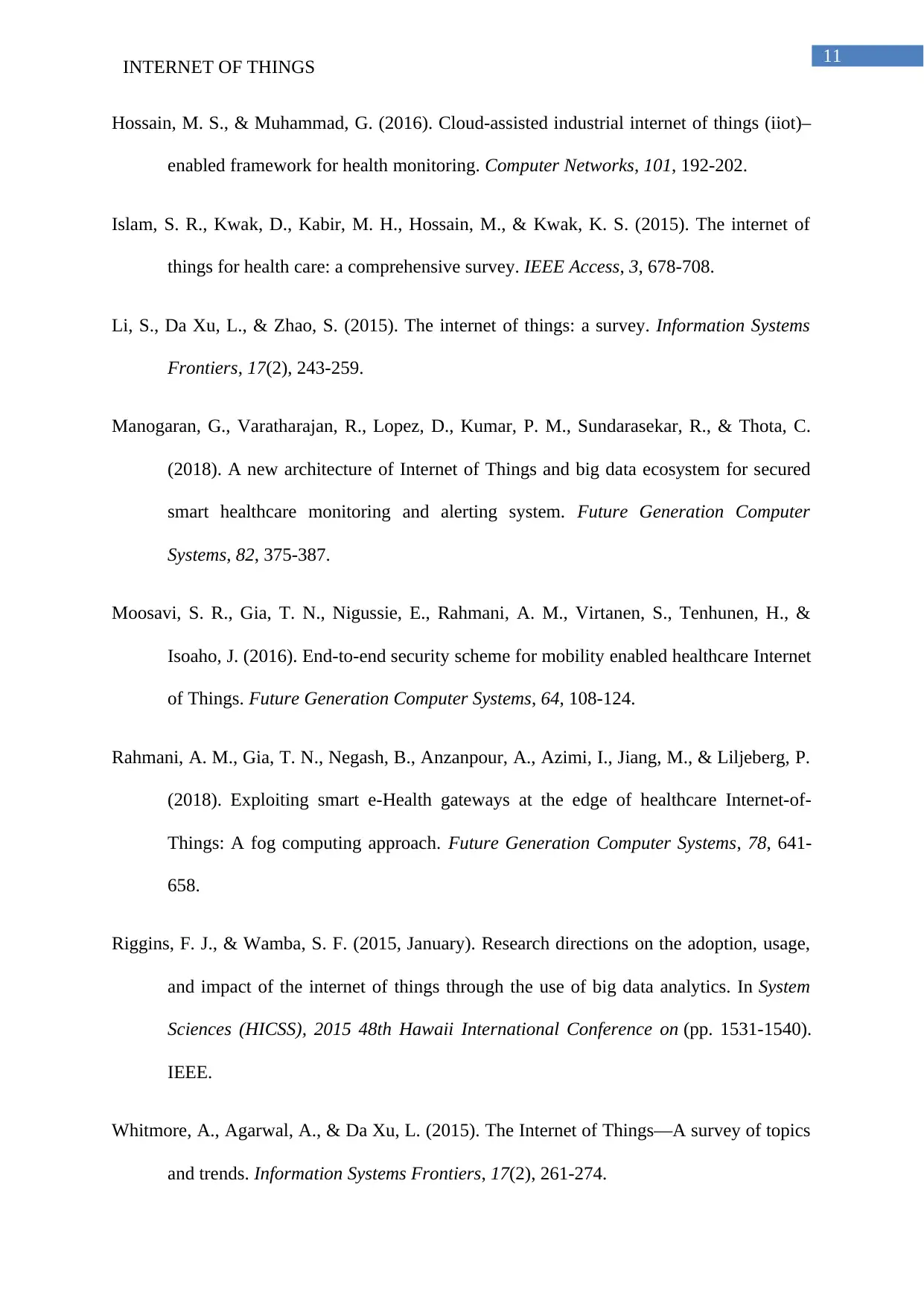
11
INTERNET OF THINGS
Hossain, M. S., & Muhammad, G. (2016). Cloud-assisted industrial internet of things (iiot)–
enabled framework for health monitoring. Computer Networks, 101, 192-202.
Islam, S. R., Kwak, D., Kabir, M. H., Hossain, M., & Kwak, K. S. (2015). The internet of
things for health care: a comprehensive survey. IEEE Access, 3, 678-708.
Li, S., Da Xu, L., & Zhao, S. (2015). The internet of things: a survey. Information Systems
Frontiers, 17(2), 243-259.
Manogaran, G., Varatharajan, R., Lopez, D., Kumar, P. M., Sundarasekar, R., & Thota, C.
(2018). A new architecture of Internet of Things and big data ecosystem for secured
smart healthcare monitoring and alerting system. Future Generation Computer
Systems, 82, 375-387.
Moosavi, S. R., Gia, T. N., Nigussie, E., Rahmani, A. M., Virtanen, S., Tenhunen, H., &
Isoaho, J. (2016). End-to-end security scheme for mobility enabled healthcare Internet
of Things. Future Generation Computer Systems, 64, 108-124.
Rahmani, A. M., Gia, T. N., Negash, B., Anzanpour, A., Azimi, I., Jiang, M., & Liljeberg, P.
(2018). Exploiting smart e-Health gateways at the edge of healthcare Internet-of-
Things: A fog computing approach. Future Generation Computer Systems, 78, 641-
658.
Riggins, F. J., & Wamba, S. F. (2015, January). Research directions on the adoption, usage,
and impact of the internet of things through the use of big data analytics. In System
Sciences (HICSS), 2015 48th Hawaii International Conference on (pp. 1531-1540).
IEEE.
Whitmore, A., Agarwal, A., & Da Xu, L. (2015). The Internet of Things—A survey of topics
and trends. Information Systems Frontiers, 17(2), 261-274.
INTERNET OF THINGS
Hossain, M. S., & Muhammad, G. (2016). Cloud-assisted industrial internet of things (iiot)–
enabled framework for health monitoring. Computer Networks, 101, 192-202.
Islam, S. R., Kwak, D., Kabir, M. H., Hossain, M., & Kwak, K. S. (2015). The internet of
things for health care: a comprehensive survey. IEEE Access, 3, 678-708.
Li, S., Da Xu, L., & Zhao, S. (2015). The internet of things: a survey. Information Systems
Frontiers, 17(2), 243-259.
Manogaran, G., Varatharajan, R., Lopez, D., Kumar, P. M., Sundarasekar, R., & Thota, C.
(2018). A new architecture of Internet of Things and big data ecosystem for secured
smart healthcare monitoring and alerting system. Future Generation Computer
Systems, 82, 375-387.
Moosavi, S. R., Gia, T. N., Nigussie, E., Rahmani, A. M., Virtanen, S., Tenhunen, H., &
Isoaho, J. (2016). End-to-end security scheme for mobility enabled healthcare Internet
of Things. Future Generation Computer Systems, 64, 108-124.
Rahmani, A. M., Gia, T. N., Negash, B., Anzanpour, A., Azimi, I., Jiang, M., & Liljeberg, P.
(2018). Exploiting smart e-Health gateways at the edge of healthcare Internet-of-
Things: A fog computing approach. Future Generation Computer Systems, 78, 641-
658.
Riggins, F. J., & Wamba, S. F. (2015, January). Research directions on the adoption, usage,
and impact of the internet of things through the use of big data analytics. In System
Sciences (HICSS), 2015 48th Hawaii International Conference on (pp. 1531-1540).
IEEE.
Whitmore, A., Agarwal, A., & Da Xu, L. (2015). The Internet of Things—A survey of topics
and trends. Information Systems Frontiers, 17(2), 261-274.
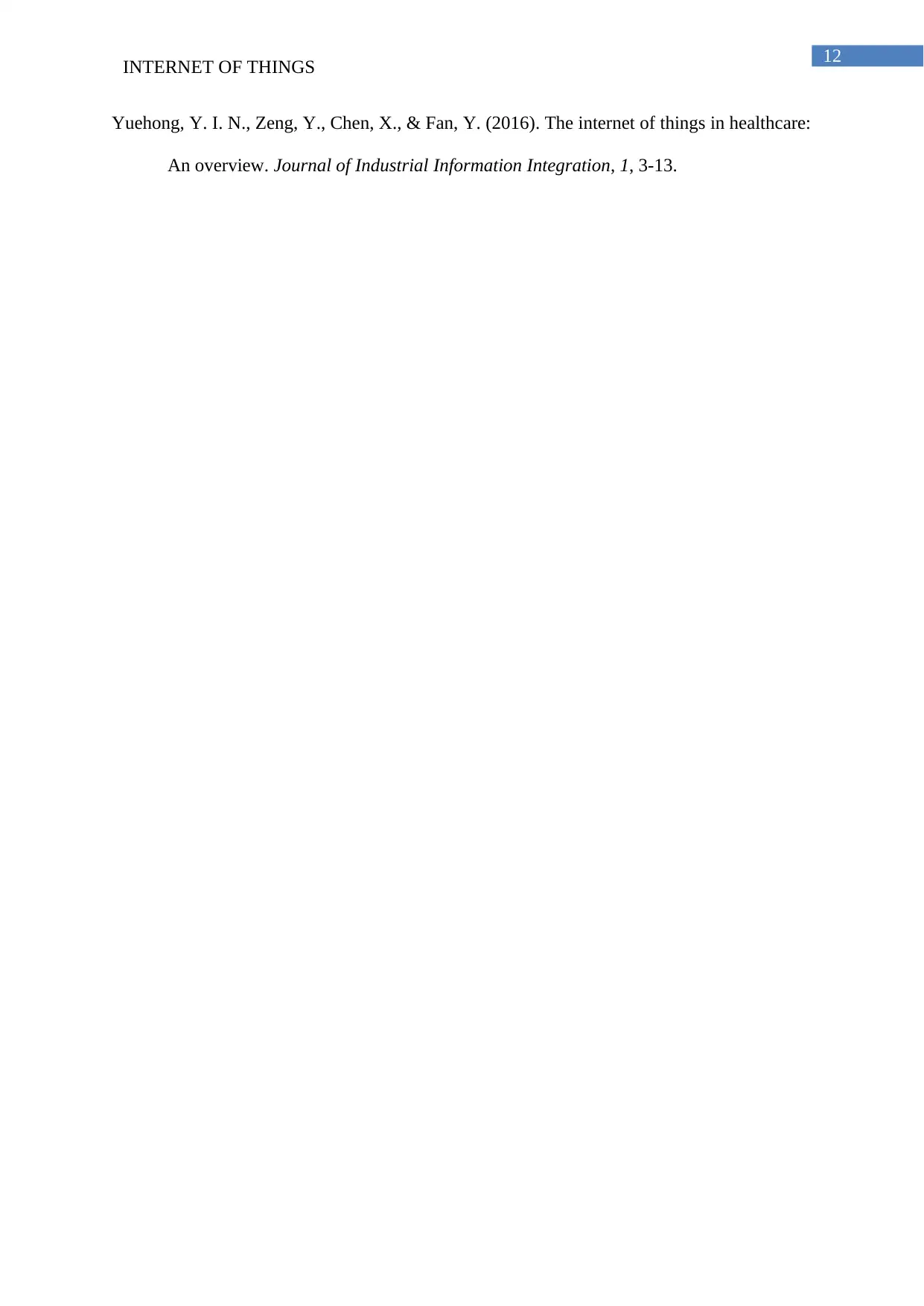
12
INTERNET OF THINGS
Yuehong, Y. I. N., Zeng, Y., Chen, X., & Fan, Y. (2016). The internet of things in healthcare:
An overview. Journal of Industrial Information Integration, 1, 3-13.
INTERNET OF THINGS
Yuehong, Y. I. N., Zeng, Y., Chen, X., & Fan, Y. (2016). The internet of things in healthcare:
An overview. Journal of Industrial Information Integration, 1, 3-13.
1 out of 13
Related Documents
Your All-in-One AI-Powered Toolkit for Academic Success.
+13062052269
info@desklib.com
Available 24*7 on WhatsApp / Email
![[object Object]](/_next/static/media/star-bottom.7253800d.svg)
Unlock your academic potential
© 2024 | Zucol Services PVT LTD | All rights reserved.




